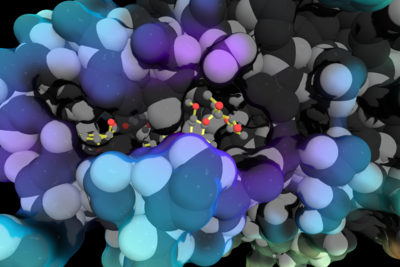Art:Opening a Gate to Human Health
From Proteopedia
Behind the Artwork and the Protein Structure
In the 1970s, an exciting discovery of a family of medicines was made by the Japanese scientist Satoshi Ōmura. It is one of these molecules which features in this artwork, created by Alice Clark from PDBe. It shows ivermectin bound in the ligand binding pocket of the Farnesoid X receptor, a protein which helps regulate cholesterol in humans. This structure showed that ivermectin induced transcriptional activity of FXR and could be used to regulate metabolism. The scientists suggest FXR as a potential mammalian drug target of ivermectin.
View in 3D or go to PDB structure 4wvd [1]
An Exciting Discovery
Dr. Ōmura identified a chemical from the soil bacterium Streptomyces avermitilis which was able to kill worms and lice. He called it avermectin, and it is a member of a family of naturally occurring chemical compounds which S.avermitilis produces. Following its discovery, William C. Campbell at the pharmaceutical company Merck purified avermectin from cultures that he obtained from Dr. Ōmura. The compounds were then further characterised and developed resulting in a derivative of avermectin with even greater potency and lower toxicity. This drug is the potent antiworm and insecticide called Ivermectin. For this, Dr. Campbell and Dr. Ōmura shared part of the 2015 Nobel Prize in medicine.
How Ivermectin Works
In organisms affected by Ivermectin, it causes paralysis and ultimately death. It binds to glutamate-gated chloride channels - proteins in the membranes of nerve and muscle cells which let in chloride ions to pass the signal along. Because Ivermectin binds specifically to channels in invertebrates it leaves the channels in vertebrate cells, such as those in humans, unaffected. It specifically binds to the membrane spanning region (PDB entry 3ri5), causing the channel to be stuck on ‘open’. This leads to increased permeability of chloride ions across the membrane and the inability of the nerves to pass on signals.
An Important Medicine
Medical use of Ivermectin began in 1981 and it is now on the World Health Organization's list of essential medicines. One target of this drug are parasitic worms, which are estimated to afflict one third of the world's people. Infections are most prevalent in sub-Saharan Africa, South Asia and Central and South America. Two examples of diseases caused by worms are River Blindness and Lymphatic Filariasis. River Blindness leads to blindness due to inflammation of the cornea of the eye and Lymphatic Filariasis causes chronic swelling in the body leading to life-long stigmatizing and disabling clinical symptoms, including Elephantiasis. Invermectin is particularly effective because it only needs to be taken once or twice a year, does not require refrigeration, and has a wide margin of safety at the required dose. For these reasons it does not need highly skilled health workers to administer it. The cost for a course of treatment in the developing world is about 12 US cents. Since 1988 it has been provided free of charge for use in humans by Merck through the Mectizan donation program.
Explore the scientific publication
- ↑ Jin L, Feng X, Rong H, Pan Z, Inaba Y, Qiu L, Zheng W, Lin S, Wang R, Wang Z, Wang S, Liu H, Li S, Xie W, Li Y. The antiparasitic drug ivermectin is a novel FXR ligand that regulates metabolism. Nat Commun. 2013;4:1937. doi: 10.1038/ncomms2924. PMID:23728580 doi:10.1038/ncomms2924

